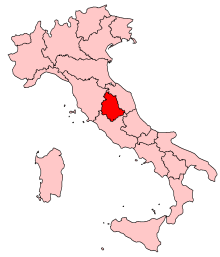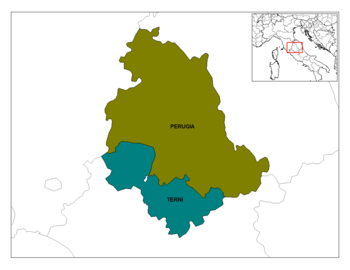Umbria
| Umbria | |||
| Flag | Coat of arms | ||
|
|||
| Location | |||
 |
|||
| Time zone | CET/CEST (UTC+1/+2) | ||
| Administration | |||
| Country | Italy | ||
| NUTS Region | ITE | ||
| Capital | Perugia | ||
| President | Maria Rita Lorenzetti (Democratic Party) | ||
| Basic statistics | |||
| Area | 8,456 km² (3,265 sq mi) (Ranked 16th, 2.8 %) |
||
| Population | 884,450 (12/2007) (Ranked 17th, 1.5 %) |
||
| - Density | 105 /km² (271 /sq mi) | ||
| Other information | |||
| GDP/ Nominal | € 20.6 billion (2006) | ||
| Website | www.regione.umbria.it | ||
Umbria is one of the 20 Regions of Italy. The capital is Perugia. It has an area of 8,456 km² and about 900,000 inhabitants.
Contents |
Geography
Umbria is a region of Central Italy, bordered by Tuscany to the west, the Marche to the east and Lazio to the south. This region is mostly hilly or mountainous. Its topography is dominated by the Apennines to the east, with the highest point in the region at Monte Vettore on the border of the Marche (2476 m = 8123 ft), and the Tiber valley basin, with the lowest point at Attigliano (96 m = 315 ft).
Umbria is divided in two provinces:

- Perugia
- Terni
The Tiber forms the approximate border with Lazio; although its course northwards from its source just over the Tuscan border lies in Umbria, the river course is changeable and thus few towns have been built on it: the Tiber itself is not a major factor in the history and human geography of Umbria. The same cannot be said of the Tiber's three principal tributaries, each flowing in a generally southward course. The course of the Chiascio takes it through relatively uninhabited areas until Bastia Umbra, and about 10 km later it flows into the Tiber at Torgiano. The Topino, cleaving the Apennines with passes that the Via Flaminia and successor roads follow, makes a sharp turn at Foligno to flow NW for a few kilometres before joining the Chiascio below Bettona. The third river is the Nera, flowing into the Tiber further south, at Terni; its valley, called the Valnerina, is widely considered to be the most scenic area of Umbria. While the upper Nera flows more or less in isolation in the mountains, the lower course of the Chiascio-Topino basin is a fairly large floodplain, which in Antiquity was a pair of shallow, interlocking lakes, the Lacus Clitorius and the Lacus Umber. They were drained by the Romans over several hundred years, but an earthquake in the 4th century and the political collapse of the Roman Empire resulted in the reflooding of the basin, which was drained a second time over five hundred years; Benedictine monks started the process in the 13th century, and it was completed by an engineer from Foligno in the 18th century.
In tourist literature one sometimes sees Umbria called il cuor verde d'Italia (the green heart of Italy). The phrase, taken from a poem by Giosuè Carducci — the subject of which is not Umbria but rather a specific place in it, the source of the Clitunno river, treasured as a beauty spot — is to a certain extent appropriate since the modern administrative region is the only one to have neither a coast nor a border with a foreign country, and, except for August and September, is famously green.

History
The region is named for the Umbri tribe, who settled in the region in protohistoric times (6th century BC): 672 BC is the legendary date of foundation of the town of Terni (Interamna). Their language was Umbrian, a relative of Latin and Oscan.
Archaeological evidence shows that the Umbri can be identified with the creators of the Terramara, and probably also of the Villanovan culture in northern and central Italy, who at the beginning of the Bronze Age displaced the original Ligurian population by an invasion from the north-east. It may be provisionally inferred that the Umbrians were closely related to the Achaeans of prehistoric Greece. Pliny the Elder's statement that they were the most ancient race of Italy is certainly wrong.
The Etruscans were chief enemies of the Umbri, and the Etruscan invasion went from the western seaboard towards the north and east (lasting from about 700 to 500 BC), eventually driving the Umbrians towards the Apenninic uplands and capturing 300 Umbrian towns. Nevertheless, the Umbrian population does not seem to have been eradicated in the conquered districts.
After the downfall of the Etruscans, Umbrians attempted to aid the Samnites in their struggle against Rome (308 BC); but communications with Samnium were impeded by the Roman fortress of Narni (founded 298 BC). At the great battle of Sentinum (295 BC), which was fought in their own territory, the Umbrians did not substantially help the Samnites.

The Roman victory at Sentinum started a period of integration under the Roman rulers, who established some colonies (e.g., Spoletium) and built the via Flaminia (220 BC), which became a principal vector for Roman development in Umbria. During Hannibal's invasion in the second Punic war, the battle of Lake Trasimene was fought in Umbria, but the Umbrians did not aid him.
During the Roman civil war between Mark Antony and Octavian (40 BC), the city of Perugia supported Antony and was almost completely destroyed by the latter.
In Pliny’s time, 49 independent communities still existed in Umbria, and the abundance of inscriptions and the high proportion of recruits in the imperial army attest to its population.
The modern region of Umbria, however, is essentially different from the Umbria of Roman times (see Roman Umbria), which extended through most of what is now the northern Marche, to Ravenna, but excluded the west bank of the Tiber. Thus Perugia was in Etruria, and the area around Norcia was in the Sabine territory.
After the collapse of the Roman empire, Ostrogoths and Byzantines struggled for the supremacy in the region; the Lombards founded the duchy of Spoleto, covering much of today's Umbria, and ruled from 571 to the 13th century. When Charlemagne conquered most of the Lombard kingdoms, some Umbrian territories were given to the Pope, who established temporal power over them. Some cities acquired a form of autonomy (the comuni); they were often at war with each other in the context of the more general conflict between the papacy and the Holy Roman Empire or between the Guelphs and the Ghibellines.
In the 14th century, the signorie arose, but were subsumed into the Papal States, which ruled the region until the end of the 18th century. After the French Revolution and the French conquest of Italy, Umbria was part of the ephemeral Roman Republic (1789–1799) and of the Napoleonic Empire (1809–1814). After Napoleon's defeat, the Pope regained Umbria until 1860. After the Risorgimento and the Piedmontese expansion, Umbria was incorporated in the Kingdom of Italy.
The borders of Umbria were fixed in 1927, with the creation of the province of Terni and the separation of the province of Rieti, which was incorporated in Lazio.
Economy
The agriculture of the region produces olives, grapes, wheat and tobacco. Industry is based on the steel factories of Terni that harness the hydroelectric power of the Marmore Falls created by the Romans, the food industry of Perugia (e.g. Perugina-Nestlè), the production of olive oil (Spoleto and Trevi) and wine (Lake Trasimeno, Montefalco). Tourism is an important factor in the regional economy, especially in the districts of Perugia, Assisi, and Spoleto.
Politics
Umbria is a stronghold of the center-left coalition The Union, forming with Tuscany, Emilia-Romagna and Marche the famous Italian political "Red Quadrilateral". At the April 2006 elections, Umbria gave more than 57% of its votes to Romano Prodi.
Demographics
As of 2006, the Italian national institute of statistics ISTAT estimated that 53,470 foreign-born immigrants live in Umbria, equal to 6.2% of the total population of the region.
Towns of Umbria with a population of 20,000 or more:
| Comune | Population (2006 est.) |
|---|---|
| Perugia | 161,390 |
| Terni | 109,569 |
| Foligno | 54,381 |
| Città di Castello | 39,492 |
| Spoleto | 38,563 |
| Gubbio | 32,532 |
| Assisi | 26,196 |
| Orvieto | 20,841 |
| Bastia Umbra | 20,760 |
| Narni | 20,212 |
References
- This article incorporates text from the Encyclopædia Britannica Eleventh Edition, a publication now in the public domain.
External links
|
|||||

